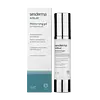What's inside
What's inside
 Key Ingredients
Key Ingredients

 Benefits
Benefits

 Concerns
Concerns

 Ingredients Side-by-side
Ingredients Side-by-side

Water
Skin ConditioningPropanediol
SolventPotassium Azeloyl Diglycinate
Skin ConditioningPropylene Glycol
HumectantPolysorbate 20
EmulsifyingTitanium Dioxide
Cosmetic ColorantLecithin
EmollientTriethanolamine
BufferingAmmonium Acryloyldimethyltaurate/Vp Copolymer
Alcohol
AntimicrobialAcrylamide/Sodium Acryloyldimethyltaurate Copolymer
Emulsion StabilisingAcrylates/C10-30 Alkyl Acrylate Crosspolymer
Emulsion StabilisingAzelaic Acid
BufferingBenzyl Salicylate
PerfumingC13-14 Isoparaffin
EmollientCetylpyridinium Chloride
AntimicrobialCichorium Intybus Root Extract
MaskingCitronellol
PerfumingEthylhexylglycerin
Skin ConditioningHydrochloric Acid
BufferingHydrogenated Lecithin
EmulsifyingLaureth-7
EmulsifyingLeptospermum Scoparium Branch/Leaf Oil
TonicLinalool
PerfumingMelaleuca Alternifolia Leaf Oil
AntioxidantMica
Cosmetic ColorantNiacin
SmoothingPanthenol
Skin ConditioningPantolactone
HumectantParfum
MaskingPhenoxyethanol
PreservativePhytosphingosine Hcl
Skin ConditioningPotassium Sorbate
PreservativeRetinal
Skin ConditioningRetinyl Palmitate
Skin ConditioningSilybum Marianum Extract
Skin ConditioningSodium Chloride
MaskingSodium Cholate
Skin ConditioningSodium Hyaluronate
HumectantSodium Hydroxide
BufferingTin Oxide
AbrasiveTocopherol
AntioxidantTranexamic Acid
AstringentTriticum Vulgare Germ Extract
Skin ConditioningWater, Propanediol, Potassium Azeloyl Diglycinate, Propylene Glycol, Polysorbate 20, Titanium Dioxide, Lecithin, Triethanolamine, Ammonium Acryloyldimethyltaurate/Vp Copolymer, Alcohol, Acrylamide/Sodium Acryloyldimethyltaurate Copolymer, Acrylates/C10-30 Alkyl Acrylate Crosspolymer, Azelaic Acid, Benzyl Salicylate, C13-14 Isoparaffin, Cetylpyridinium Chloride, Cichorium Intybus Root Extract, Citronellol, Ethylhexylglycerin, Hydrochloric Acid, Hydrogenated Lecithin, Laureth-7, Leptospermum Scoparium Branch/Leaf Oil, Linalool, Melaleuca Alternifolia Leaf Oil, Mica, Niacin, Panthenol, Pantolactone, Parfum, Phenoxyethanol, Phytosphingosine Hcl, Potassium Sorbate, Retinal, Retinyl Palmitate, Silybum Marianum Extract, Sodium Chloride, Sodium Cholate, Sodium Hyaluronate, Sodium Hydroxide, Tin Oxide, Tocopherol, Tranexamic Acid, Triticum Vulgare Germ Extract
Salicylic Acid 2%
MaskingWater
Skin ConditioningGlycerin
HumectantIsononyl Isononanoate
EmollientButylene Glycol
HumectantKaolin
AbrasiveZinc Sulfate
AntimicrobialBifida Ferment Lysate
Skin ConditioningSodium Hydroxide
BufferingSodium Polyacrylate
AbsorbentSodium Hyaluronate
HumectantSodium Benzoate
MaskingPhenoxyethanol
PreservativeAscorbyl Glucoside
AntioxidantHydrolyzed Algin
Trisodium Ethylenediamine Disuccinate
Biosaccharide Gum-1
HumectantAcrylates/C10-30 Alkyl Acrylate Crosspolymer
Emulsion StabilisingParfum
MaskingSalicylic Acid 2%, Water, Glycerin, Isononyl Isononanoate, Butylene Glycol, Kaolin, Zinc Sulfate, Bifida Ferment Lysate, Sodium Hydroxide, Sodium Polyacrylate, Sodium Hyaluronate, Sodium Benzoate, Phenoxyethanol, Ascorbyl Glucoside, Hydrolyzed Algin, Trisodium Ethylenediamine Disuccinate, Biosaccharide Gum-1, Acrylates/C10-30 Alkyl Acrylate Crosspolymer, Parfum
 Reviews
Reviews

Alternatives
Ingredients Explained
These ingredients are found in both products.
Ingredients higher up in an ingredient list are typically present in a larger amount.
Acrylates/C10-30 Alkyl Acrylate Crosspolymer is a synthetic polymer. It is used to thicken and improve the texture of products. Due to its properties, it can prevent water and oil ingredients from separating.
Parfum is a catch-all term for an ingredient or more that is used to give a scent to products.
Also called "fragrance", this ingredient can be a blend of hundreds of chemicals or plant oils. This means every product with "fragrance" or "parfum" in the ingredients list is a different mixture.
For instance, Habanolide is a proprietary trade name for a specific aroma chemical. When used as a fragrance ingredient in cosmetics, most aroma chemicals fall under the broad labeling category of “FRAGRANCE” or “PARFUM” according to EU and US regulations.
The term 'parfum' or 'fragrance' is not regulated in many countries. In many cases, it is up to the brand to define this term.
For instance, many brands choose to label themselves as "fragrance-free" because they are not using synthetic fragrances. However, their products may still contain ingredients such as essential oils that are considered a fragrance by INCI standards.
One example is Calendula flower extract. Calendula is an essential oil that still imparts a scent or 'fragrance'.
Depending on the blend, the ingredients in the mixture can cause allergies and sensitivities on the skin. Some ingredients that are known EU allergens include linalool and citronellol.
Parfum can also be used to mask or cover an unpleasant scent.
The bottom line is: not all fragrances/parfum/ingredients are created equally. If you are worried about fragrances, we recommend taking a closer look at an ingredient. And of course, we always recommend speaking with a professional.
Learn more about ParfumPhenoxyethanol is a preservative that has germicide, antimicrobial, and aromatic properties. Studies show that phenoxyethanol can prevent microbial growth. By itself, it has a scent that is similar to that of a rose.
It's often used in formulations along with Caprylyl Glycol to preserve the shelf life of products.
Sodium Hyaluronate is hyaluronic acid's salt form. It is commonly derived from the sodium salt of hyaluronic acid.
Like hyaluronic acid, it is great at holding water and acts as a humectant. This makes it a great skin hydrating ingredient.
Sodium Hyaluronate is naturally occurring in our bodies and is mostly found in eye fluid and joints.
These are some other common types of Hyaluronic Acid:
Learn more about Sodium HyaluronateSodium Hydroxide is also known as lye or caustic soda. It is used to adjust the pH of products; many ingredients require a specific pH to be effective.
In small amounts, sodium hydroxide is considered safe to use. However, large amounts may cause chemical burns due to its high alkaline.
Your skin has a natural pH and acid mantle. This acid mantle helps prevent harmful bacteria from breaking through. The acid mantle also helps keep your skin hydrated.
"Alkaline" refers to a high pH level. A low pH level would be considered acidic.
Learn more about Sodium HydroxideWater. It's the most common cosmetic ingredient of all. You'll usually see it at the top of ingredient lists, meaning that it makes up the largest part of the product.
So why is it so popular? Water most often acts as a solvent - this means that it helps dissolve other ingredients into the formulation.
You'll also recognize water as that liquid we all need to stay alive. If you see this, drink a glass of water. Stay hydrated!
Learn more about Water